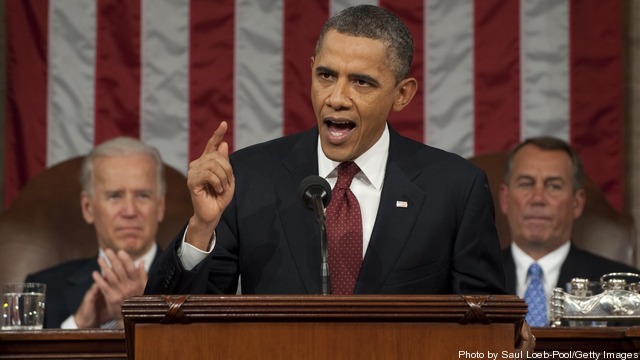
In his third state of the Union speech, President Obama kept energy as “pillar” of economic recovery and made natural gas the pivot point.
While endorsing an “all of the above” energy strategy, he added little new from the policies of the last three years, and no real surprises.
New to the speech, but hardly a surprise, was confirmation of industry expectations that the Department of Interior would require full disclosure of hydraulic fracturing fluids for any use of the technology on public lands, among other rules to ensure “responsible” development.
Interior is in the process of drawing up safety regulations under which it will open federal lands to gas drillers, which the President endorsed. Full disclosure has been widely expected. So far, all fracking has occurred on private lands. With public fears about the process’ potential environmental impacts, states are beginning to require disclosure and some producers are already disclosing voluntarily.
The Secretary of Energy’s Advisory Board fracking subcommittee recommended full disclosure last fall as a simple measure the industry could easily undertake to allay arguments from fracking opponents about the toxicity of fracking fluids.
Not new to the speech was repealing tax treatment long enjoyed by the oil industry, but the President made them a specific swap – oil for “clean energy.” Oil tax revenues were the President’s preferred source of funding for clean energy programs – none of which were specifically called out in the State of the Union speech as they have been in the past.
However, the White House issued a separate “blueprint” for the president’s plan which included all the clean sources endorsed last year when Obama called for a Clean Energy Standard: renewables like wind, solar, biomass and hydropower, nuclear power, “efficient” natural gas, and coal with carbon capture.
Talking Tax Credits
The President did call for “clean energy tax credits,” which appeared to back renewal in some form of the expiring wind production tax credit.
Credits for solar investment are in place to 2016, but wind’s production tax credit expires at the end of 2012, and the wind industry has been lobbying for a long-term extension, rather than the traditional one to three years.
There has been speculation the production credit could be converted to an investment credit like solar, under which investors can get their tax benefits sooner.
President Obama held out an olive branch to the oil industry, promising to open 75% of US off-shore resources. Kevin Book of ClearView Energy Partners said this is part of the pending Outer Continental Shelf proposals due to be finalized by mid-year, which will continue to restrict Alaska and the Florida Atlantic coast, among other areas.
Also under that proposal, as currently drafted, federal leases would get more restrictive, he said. Now, lease holders have 10 years to develop a holding, but the new proposal would give seven years with a possible three-year extension.
The major federal initiatives in clean energy the President mentioned involved the Defense Department. The armed forces are already trying to reduce dependence on fossil fuels as a strategic objective, given vulnerable supply lines overseas. The US Navy is already heavily involved in reducing energy use at its bases, increasing engine efficiency, and substituting biofuels for petroleum-based ones on its ships.
The President mentioned only the Navy’s procuring renewable power on land and an ongoing Interior program to site more solar and wind on federal lands.
The lack of new proposals was not a surprise to many Washington observers. With the bitterly divided Congress and the national elections looming, there is no expectation of action on anything but “must pass” legislation like the payroll tax cut. Depending on those elections, as happened in 2010, some substantive measures could pass a post-election lame duck session late this year.
Photo Caption: U.S. President Barack Obama, flanked by Vice President Joe Biden (L) and House Speaker John Boehner (R-OH), delivers his State of the Union address before a joint session of Congress on Capitol Hill January 24, 2012 in Washington, DC.
